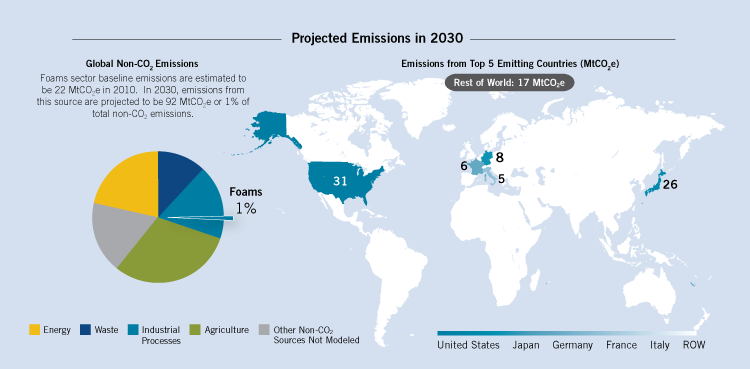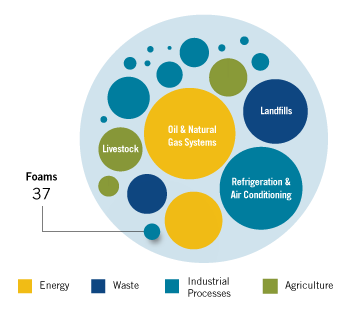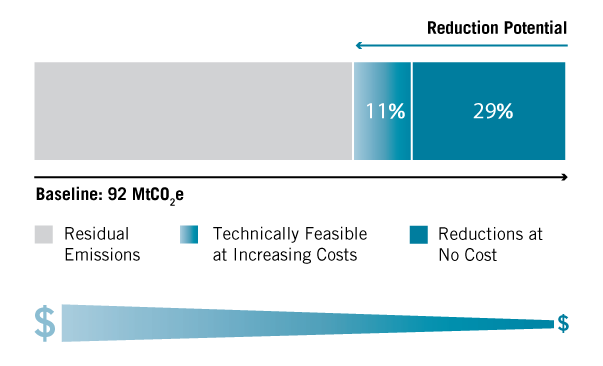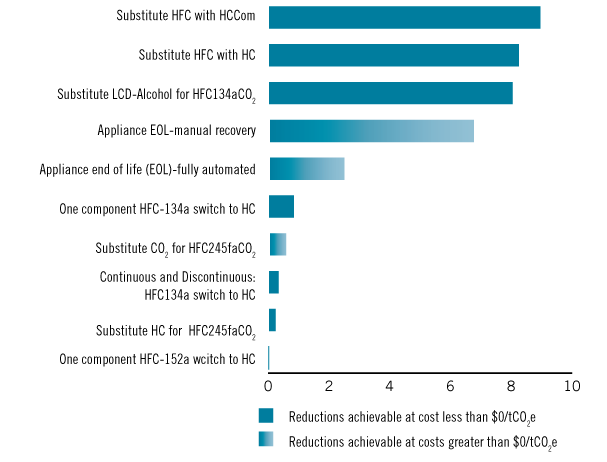Global Mitigation of Non-CO2 Greenhouse Gases: Foams
Key Points
- Hydrofluorocarbon (HFC) emissions from foams are projected to quadruple over the next 20 years.
- Abatement measures include replacing HFCs with low-GWP blowing agents and proper recovery and disposal of foam present in existing systems at their end of life.
- In 2030, the global abatement potential quantified is 27 million metric tons of carbon dioxide equivalent (MtCO2e), or 29.4% of BAU emissions from the foams sector, at cost-effective prices ($0 per tCO2e). At higher prices, the abatement options analyzed have the potential to abate up to 37 MtCO2e (40.3% of BAU emissions) in 2030.
Sector Description
Foam is used as insulation in a wide range of equipment, structures, and other common products. Foams were historically produced with ozone-depleting substances (ODS), which have been phased out under the Montreal Protocol in developed countries and are being phased out in developing countries. In some end-uses, HFC blowing agents have largely replaced ODS. HFC emissions from the foams sector were approximately 22 MtCO2e in 2010 and are projected to increase substantially to 52 MtCO2e and 92 MtCO2e by 2020 and 2030, respectively.
 View or download the full size image here.(117 K, PNG)
View or download the full size image here.(117 K, PNG)
Emissions Reduction Potential
Assuming full implementation of current technology, emissions in the foams sector could be reduced by up to 37 MtCO2e in 2030. This accounts for 1% of the 4,615 MtCO2e in global reduction potential in 2030.
 View or download the full size image here.(100 K, PNG)
View or download the full size image here.(100 K, PNG)
Abatement Potential
The total abatement potential in the foams sector from the options explored is 37 MtCO2e—40% of total annual foams sector emissions in 2030—while 27 MtCO2e, or 29%, is achievable at cost-effective carbon prices for the same year. Total replacement of HFC blowing agents in foams is limited in the near term by the installed base of foam products. All abatement options analyzed replace blowing agents in newly manufactured foams or destroy the blowing agent only at the foam’s natural end of life.
 It would be cost-effective to reduce emissions by 29%, compared to the baseline, in 2030. An additional 11% reduction is available using technologies with increasingly higher costs.
It would be cost-effective to reduce emissions by 29%, compared to the baseline, in 2030. An additional 11% reduction is available using technologies with increasingly higher costs.
View or download the full size image here.(37 K, PNG)
Abatement Measures
Abatement options considered include replacing HFCs with various low-GWP blowing agents and properly recovering and disposing of foam contained in equipment and other products after their useful life. More specifically, the use of hydrocarbon or carbon dioxide blowing agents instead of HFCs is assessed quantitatively as an abatement measure in the foams sector, noting that other low-GWP agents (e.g., HFO-1234ze, -1233zd(E)) would achieve similar abatement levels.
 Emissions reductions by technology in 2030 at $0/tCO2e and at higher prices.
Emissions reductions by technology in 2030 at $0/tCO2e and at higher prices.
View or download the full size image here.(44 K, PNG)
